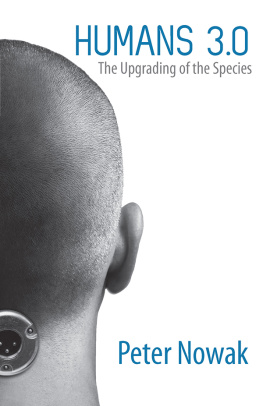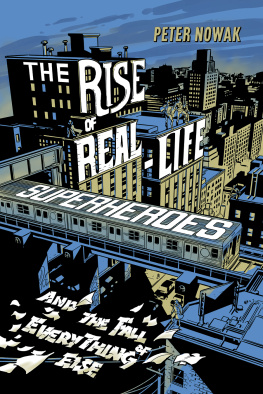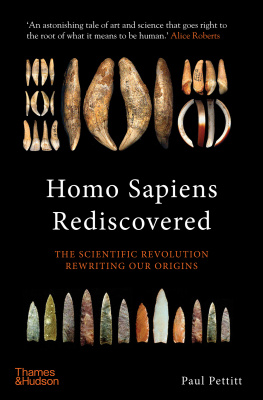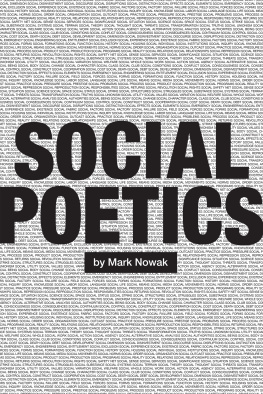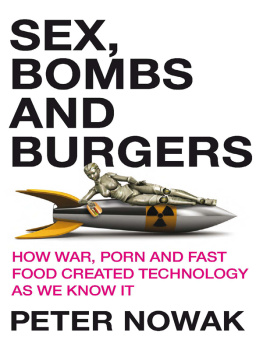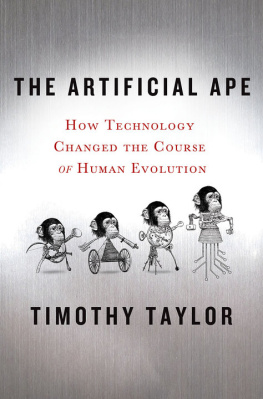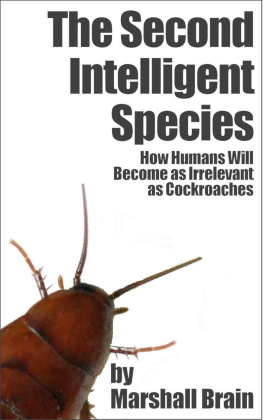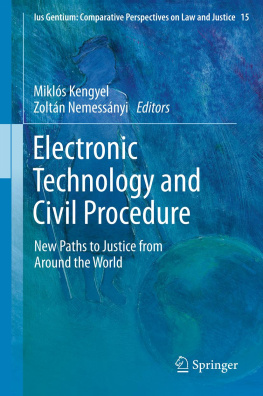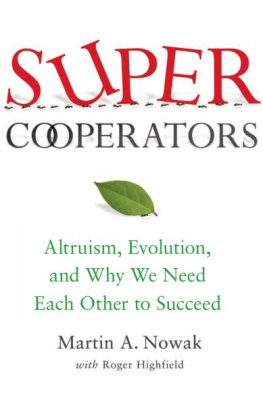Sex, Bombs, and Burgers: How War, Pornography, and Fast Food Have Shaped Modern Technology
An imprint of Rowman & Littlefield
Distributed by NATIONAL BOOK NETWORK
Copyright 2015 by Peter Nowak
All rights reserved. No part of this book may be reproduced or transmitted in any form by any means, electronic or mechanical, including photocopying and recording, or by any information storage and retrieval system, except as may be expressly permitted in writing from the publisher.
British Library Cataloguing-in-Publication Information available
Library of Congress Cataloging-in-Publication Data
eISBN 978-1-4930-1621-1 (eBook)
Nowak, Peter, 1974
Humans 3.0 : the upgrading of the species / Peter Nowak.
pages cm
Includes index.
ISBN 978-0-7627-8700-5 (alk. paper)
1. TechnologySocial aspects. 2. Technological innovationsSocial aspects. 3. Technology and civilization. 4. Social evolution. I. Title.
T14.5.N69 2015
303.483dc23
2014037165
For my mom
Changes arent permanent, but change is.
Tom Sawyer, Rush
Contents
Evolution: Of Rice and Men
Boast not thyself of tomorrow for thou knowest not what a day may bring forth.
Proverbs 27:1
Ask an anthropologist what we are as a species, and you might get a response explaining the main branches or epochs of human evolution. Biological developments or environmental changes caused the differences in each step from Australopithecines to Neanderthals to the Homo genus. Our brows became less sloped because our brains got bigger, or we stood more upright so that we could run faster, and so on. These little advances decided which of the various human subspecies ultimately won out, although scientists still disagree on exactly how or why this happened. One line of thinking, for example, believes that Homo sapiens outlasted Neanderthals because they were better able to adapt to the Ice Age. Whatever the case, we are todayand have been for the past two hundred thousand years or sothe last surviving subspecies of humans: Homo sapiens sapiens .
But that doesnt really answer the question. The definition of what we are cant be limited to simple biological evolution because that branch of science doesnt exclusively explain what it is to be human. As any student of psychology knows, people are products of both their biology and environment, which involves their upbringing and surroundings. In this classic nature-versus-nurture dichotomy, the long-debated question is which of the two exerts more influence in determining who we are.
In the early days of human evolutionhundreds of thousands of years agoit was an even combination of the two. With different subspecies competing for limited resources, our ancestors had to adapt to their environments quickly, hence the bigger brains, better posture, and other physiological changes that took place over a relatively short time period. But, as Homo sapiens won out and the others died off, that initially speedy biological evolution slowed down, eventually settling into a snails pace.
Business cycles behave in the same way. In a given industry, companies compete for market share with a certain product or service. When one emerges the winner and ultimately becomes a monopoly, innovation slows and sometimes stops entirely. Homo sapiens are like Microsoft, except they monopolized evolution rather than the home computer software market. If an antitrust regulator back then had quashed that evolutionary monopoly, innovation might have continued at the same pace, meaning we all would have wings and psychic powers by now. But that didnt happen, which is why were not Homo superior or the superpowered mutants found in X-Men comics. Human biological developments in the modern age have been few and slow going, the most notablethough still relatively minorbeing further height increases or less body hair. Perhaps in the near future, Homo superior will arise: Hairless Man, a superhero who can swim hard, fast, and far when naked.
Today and into the future, its the second factorthe environmentthats becoming much more important to continued human evolution. This is because technology, the main tool by which people affect their environments, is moving at the opposite pace of biology. Rather than slowing to a trickle, technologys rate of advancement is skyrocketing.
In 1965, chemist and businessman Gordon Moore observed that the number of transistors on an integrated circuit had doubled every year since it was invented in 1958. He estimated the trend would continue for at least another decade. He was right in his basic evaluation but wildly wrong, in a good way, about the time frame. His observation became Moores Law and has expanded into a golden rule that governs pretty much all of technology. Generally speaking, it posits that the performance and power of just about all forms of technology double every two years or so, yet prices stay the same or decline. This is largely why everything from computers to phones gets more powerful, cheaper, or both every year. Its also why that flat-panel TV you bought for thousands of dollars a few years ago is worth practically nothing today. Moore later cofounded Silicon Valley stalwart Intel, which has kept his theory alive and moving.
Moores Law has fueled many of the dramatic technological advancements of the past half-century, from the moon landing to the Internet. Just about every digital electronic component benefits from fast and steady improvements in price and performance. New technologies have come into being, and existing ones have gotten better. The real magic, meanwhile, happens when those various components combine in new and interesting ways.
Lets consider a host of random, disparate technologies and gadgets: say, a computer processor, GPS, battery, microphone, camera, speaker, memory storage, graphics chip, wireless radio, and touch screen. Each of these items was derived from decades of research and development, and each became better, smaller, and cheaper over that time. For example, early microphonesbig, bulky metallic thingscost a small fortune. Today, theyre pin-sized and can be had for pennies. Computer processors and their constituent circuits used to take up entire rooms, whereas now you need a microscope to see them.
What happens when you combine all of those ingredients? A smartphone, one device that really consists of many technologies. A typical smartphone contains thousands of singular innovations ruled by Moores Law that collectively combine into something far more powerful. They stack on one another, each new invention making possible a whole host of newer inventions. As the stack advances and builds, the rate at which the innovations accrue also increases. The pieces might move slowly at first, but, once the numbers start to build, they multiply rapidly. (Remember the graph of y = x2 from algebra class? Thats how the phenomenon looks.)
The best way to understand Moores Law is through the old story about the invention of chess. A clever inventor takes his game to the emperor of the land, who is so impressed that he tells the man to name his reward. The inventor asks for a quantity of rice as follows: one grain for the first square on the board, two for the second, four for the third, eight for the fourth, and so on, with the amount doubling for each subsequent square. Emperors arent necessarily math wizards, so the ruler laughs at the reward as small but grants it. The inventor continues, and, after completing the first half of the chessboard, his reward still isnt very impressive. As futurist Ray Kurzweil puts it in The Age of Spiritual Machines ,

